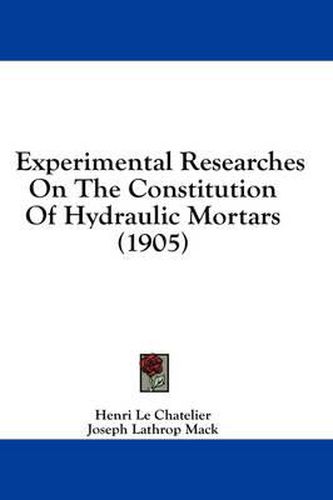Readings Newsletter
Become a Readings Member to make your shopping experience even easier.
Sign in or sign up for free!
You’re not far away from qualifying for FREE standard shipping within Australia
You’ve qualified for FREE standard shipping within Australia
The cart is loading…






Purchase of this book includes free trial access to www.million-books.com where you can read more than a million books for free. This is an OCR edition with typos. Excerpt from book: PART III. CALCAREOUS MORTARS. The calcareous mortars are divisible into two categories: Air mortars; and Hydraulic mortars. I shall say only a few words of the first. I have studied these only so far as they might throw some light upon the hydraulic mortars, the only purpose that I have in view here. AIR MORTARS These mortars are made with sand and slaked lime, that is, pulverulent calcium hydrate obtained by the action of water upon quick lime. Their set, as Vicat has shown, results entirely, at least in their first stage, from dessication which brings into intimate contact the extremely tenuous particles of lime. This phenomenon is identical with that of the hardening of clay. The sand acts in the same way as when it is added to clay for brick making. It prevents the shrinkage, which would necessarily accompany the desiccation, from being felt throughout the entire mass, and which would be shown by cracks in the mortar throughout its thickness, preventing any solidity. The grains of sand in contact form an incompressible matrix which prevents the shrinking from taking place except in the intervals existing between these grains and producing thus dis- continuous voids which diminish, it is true, the full section and in consequence the strength, but no where causes a complete break in continuity. It is seen why these are called air mortars; evidently they cannot ever harden under water, nor in any other places where evaporation will be impossible. Similar mortars five hundred years old have been found in the middle of massive blocks of masonry as soft as the day they were used. If these mortars, after drying out become wet, they soften again and lose all consistency. Therefore, up to this point they will show no advantage over mortars made with clay. But a se…
$9.00 standard shipping within Australia
FREE standard shipping within Australia for orders over $100.00
Express & International shipping calculated at checkout
Purchase of this book includes free trial access to www.million-books.com where you can read more than a million books for free. This is an OCR edition with typos. Excerpt from book: PART III. CALCAREOUS MORTARS. The calcareous mortars are divisible into two categories: Air mortars; and Hydraulic mortars. I shall say only a few words of the first. I have studied these only so far as they might throw some light upon the hydraulic mortars, the only purpose that I have in view here. AIR MORTARS These mortars are made with sand and slaked lime, that is, pulverulent calcium hydrate obtained by the action of water upon quick lime. Their set, as Vicat has shown, results entirely, at least in their first stage, from dessication which brings into intimate contact the extremely tenuous particles of lime. This phenomenon is identical with that of the hardening of clay. The sand acts in the same way as when it is added to clay for brick making. It prevents the shrinkage, which would necessarily accompany the desiccation, from being felt throughout the entire mass, and which would be shown by cracks in the mortar throughout its thickness, preventing any solidity. The grains of sand in contact form an incompressible matrix which prevents the shrinking from taking place except in the intervals existing between these grains and producing thus dis- continuous voids which diminish, it is true, the full section and in consequence the strength, but no where causes a complete break in continuity. It is seen why these are called air mortars; evidently they cannot ever harden under water, nor in any other places where evaporation will be impossible. Similar mortars five hundred years old have been found in the middle of massive blocks of masonry as soft as the day they were used. If these mortars, after drying out become wet, they soften again and lose all consistency. Therefore, up to this point they will show no advantage over mortars made with clay. But a se…